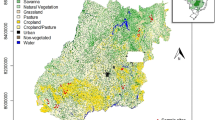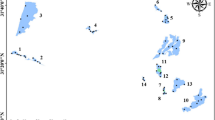Abstract.
We conducted streamside experiments to determine if the ability of herbivorous insects to remove algal periphyton varies with local current velocity. We used two mayfly species (Baetis bicaudatus and Drunella grandis) and one caddisfly species (Glossosoma verdona), which differ from one another in body morphology and mobility. Periphyton was grown for 30 days on ceramic tiles in constant velocity to create similar initial forage conditions for grazers. Tiles were transferred to three velocity regimes characteristic of the natural streambed: slow (3–5 cm s–1), medium (15–20 cm s–1) and fast (32–41 cm s–1). Four grazer treatments (Baetis, Drunella, and Glossosoma alone, and all species combined) were repeated for each velocity treatment to isolate the effect of local current on grazer ability to crop periphyton. Grazers differed in their abilities to remove periphyton across current treatments. Glossosoma removed significantly (P<0.05) more periphyton at fast versus either slow or medium velocities; Baetis showed a similar (but non-significant) trend; and, Drunella always removed about 75% of periphyton, irrespective of current. At fast current, periphyton removal was equivalent among the species. At medium current, Drunella removed significantly more than both Baetis and Glossosoma, whereas at slow current, Drunella removed more than Baetis, which removed more than Glossosoma. Periphyton removal under the combined three-grazer treatment was similar qualitatively to the combined effects of individual grazers. More periphyton tended to be removed as current increased, with the fast versus slow contrast showing marginal significance (P=0.10). Under all current regimes, the quantity of periphyton removed did not differ from the null model expectation of simple additive effects among individual grazers (i.e., no facilitation or inhibition). These experiments show that for some species, herbivory varies with current, which suggests that the herbivore "function" of cropping periphyton may vary with the environmental context of local current. Under some local velocities, however, different herbivore species "function" similarly and are potentially redundant with respect to periphytic removal. In naturally heterogeneous streams characterized by sharp gradients in local current velocity, we expect current-dependent species interactions to be common and at least partially contribute to intra-guild co-existence of species.
Similar content being viewed by others
Author information
Authors and Affiliations
Additional information
Electronic Publication
Rights and permissions
About this article
Cite this article
Poff, L.N., Wellnitz, T. & Monroe, J.B. Redundancy among three herbivorous insects across an experimental current velocity gradient. Oecologia 134, 262–269 (2003). https://doi.org/10.1007/s00442-002-1086-2
Received:
Accepted:
Issue Date:
DOI: https://doi.org/10.1007/s00442-002-1086-2




